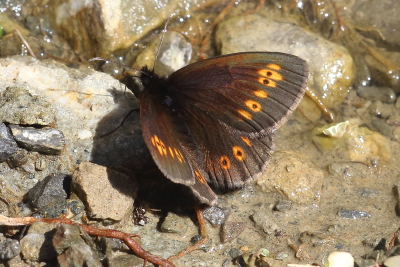








Almond-eyed Ringlet (Erebia alberganus)
2024 photographs highlighted in yellow. Click on any photograph to go to an enlarged picture, or simply scroll down the page.
|
Unlike most Erebia species, it is almost impossible to confuse alberganus with any of its cousins, except perhaps the Woodland Ringlet (E. medusa), but alberganus is an altitude species occurring at altitudes greater than 800m whereas medusa occurs from sea level and, although its can be found up to 1800m, it has very limited distribution in the French Alpes, being generally found in eastern central France.
I have found alberganus to be quite widespread, very common in most localities, making it by far the most common Erebia species I have encountered, and I find this to be true every year. In recent years, Large Ringlet (E. euryale) has increased dramatically in numbers and maybe outstrips alberganus in that respect. |
In some cases the
Bright-eyed Ringlet (E. oeme) could
be confused with alberganus; more about this on the oeme page. The female is slightly larger, as is normal for most species, and the red marks slightly larger with small white centres to the ocelli, whereas the males usually have no (or minute) white centres, although 12101 seems to contradict this. The subspecies tyrsus, which is characterised by the brighter colouring and bolder markings, occurs in the western Alpes. I suspect that all on this page are of the subspecies tyrsus. |
| ref | sex |
observations |
alt. m |
| 12101 | M |
a male, based on body shape, despite the relative lightness of the brown ground colour, which would normally indicate female. The upf and uph pupils are white and quite conspicuous, probably about as bright as alberganus gets. |
2200 |
| 17532 | M |
a typical male. |
2000 |
| 48643 | M | this is included because it is the most lightly-marked alberganus I have seen, and this is a very common and ubiquitous species. The only other option would be oeme or, perhaps, Yellow-spotted Ringlet (E. manto) but I had a clear view of the underside of 48643 and both of those can be ruled out for certain, which leaves only alberganus. | 1930 |
| 52432 | M | a male, with the ocelli very much on the internal side of the orange patches. | 2050 |
| 52456 | M | a male, with quite large orange patches. | 2050 |
| 11859 | F |
a female, seemingly the converse of 12101 as it is very dark for a female (compare the pair 7622 below) but clearly female based on body shape (although the degree of curvature of the body can be deceptive when viewed at this angle). I believe this may be of subspecies tyrsus. |
1400 |
| 30386 | F | clearly a female based on body shape and markings, and typical for this species. | 1900 |
| 12168 | F |
a female, based on the lightness of the ground colour (although not totally indicative, as noted elsewhere on this page) and from what is visible of the body shape. |
1750 |
| 7622 | PAIR |
a mating pair, female at the top. This shows that the female is a slightly lighter brown than the male, even allowing for any camera angle effects. The male ocelli have small white centres. |
1875 |
12101_male_Alpes-de-Haute-Provence_7Jul08
17532_male_Hautes-Alpes_08Jul09
52432_male_Hautes-Alpes_2Jul24
52456_male_Hautes-Alpes_2Jul24
11859_female_Alpes-Maritimes_1Jul08
30386_female_Alpes-Maritimes_4Jul12
12168_female_Hautes-Alpes_7Jul08
7622_pair_Alpes-Maritimes_26Jun07